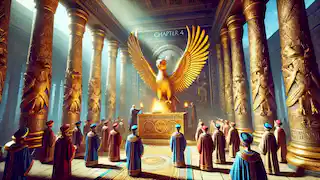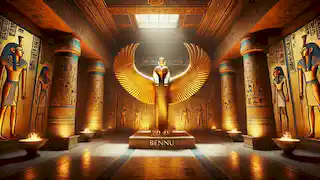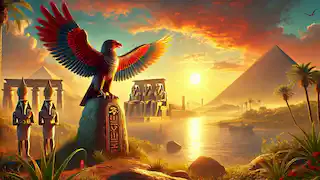In ancient Egyptian mythology, the Bennu bird holds a revered place, representing creation, rebirth, and immortality. The Bennu is often likened to the Greek Phoenix, symbolizing the cyclical nature of life and renewal. It is said to have emerged from the primeval waters, its existence tied deeply to the gods Ra and Osiris. This is a story of transformation, of life, death, and rebirth—a story that echoes through the timeless sands of Egypt. Long before the rise of the great pyramids and the grandeur of the pharaohs, Egypt was a land of primordial chaos. The universe was nothing but dark, formless waters known as Nun. But in this darkness, there was the potential for life—waiting, stirring beneath the surface. From these waters, the god Ra emerged, carrying with him the light of creation. Ra’s first task was to create a solid place where life could begin, and so he brought forth the primordial mound, known as the Benben stone. On this sacred mound, the Bennu bird landed for the very first time. With its brilliant plumage glowing like the sun at dawn, the Bennu was the first living creature in existence. As the Bennu stretched its wings and let out a cry, its voice resonated through the heavens. This cry was not just a sound, but the vibration that gave birth to time itself. With its song, the days began to turn, the sun began to rise and set, and the cycles of nature were set in motion. Thus, the Bennu bird became the symbol of the dawn of creation, a being whose existence signified the beginning of all things. But the Bennu was not just a creature of the present. It held within itself the power of eternal renewal. Just as Ra renewed the world each day by bringing the sun across the sky, so too would the Bennu’s life be a continual cycle of death and rebirth. The Egyptians believed that life was cyclical, and the Bennu bird embodied this belief. After living a long life, the Bennu would prepare for its death. It would build a nest high up in the sacred tree of Heliopolis, using only the finest herbs and fragrant branches. As the Bennu lay in its nest, it would face the setting sun, gazing toward the west, where the land of the dead lay. When the time came, the Bennu would burst into flames, consumed by the heat of the sun. But this was not an end. From the ashes, a new Bennu bird would rise, vibrant and full of life, ready to begin the cycle again. This act of self-immolation and rebirth mirrored the journey of the soul through the afterlife, a theme that was central to Egyptian religious beliefs. The cycle of the Bennu also reflected the daily journey of the sun across the sky. As the sun set each evening, it was believed to die, descending into the underworld. Yet, every morning, it would rise again, reborn and shining with new light. The Egyptians saw this in the Bennu’s continual rebirth, and so the bird became a symbol not only of life and death but also of the resurrection and immortality promised in the afterlife. The Bennu’s story is closely intertwined with the myth of Osiris, the god of the dead and the ruler of the underworld. According to legend, Osiris was once the king of Egypt, a just ruler who brought civilization to the land. But his brother, Set, was jealous of his power and murdered him, scattering his body across the land. Osiris’ wife, Isis, sought to bring her husband back to life, gathering the pieces of his body and reassembling them with the help of her magic. In her efforts, she invoked the power of the Bennu bird, whose ability to rise from its ashes mirrored Osiris’ resurrection. With the Bennu’s spirit guiding her, Isis succeeded, and Osiris was reborn as the ruler of the underworld. From then on, the Bennu was seen as a manifestation of Osiris’ power. Just as the bird could return to life after death, so too could the soul of a deceased person be reborn in the afterlife, provided they had lived a righteous life and undergone the proper rituals. The Bennu thus became a central figure in Egyptian funerary practices, symbolizing the eternal life that awaited the faithful. In the ancient city of Heliopolis, there stood a grand temple dedicated to the worship of Ra and the Bennu bird. This temple was a place of pilgrimage for Egyptians from all walks of life, from humble farmers to mighty pharaohs. The temple’s walls were adorned with intricate carvings of the Bennu, its wings outstretched, bathed in sunlight. The high priests of Heliopolis, who were responsible for maintaining the temple, would conduct rituals honoring the Bennu. They believed that by invoking the bird’s power, they could ensure the continued prosperity of the land and the protection of the pharaoh. Every morning, they would offer prayers to the Bennu, calling for the bird to rise anew, just as the sun rose in the sky. One of the most sacred ceremonies was the Festival of the Bennu, held once a year. During this festival, the priests would reenact the death and rebirth of the bird, setting a golden effigy of the Bennu alight, only for a new one to emerge, symbolizing the eternal cycle of life. This festival drew thousands of visitors from across Egypt, all eager to witness the miraculous power of the Bennu. Over time, the legend of the Bennu spread beyond Egypt’s borders. Greek travelers who visited the land were struck by the story of the Bennu, which they associated with their own myth of the Phoenix. The similarities between the two birds were striking: both were creatures of fire and renewal, both symbolized the power of rebirth, and both were believed to live for hundreds of years before returning to the ashes to be born again. As the Greeks adopted the myth, they altered it slightly to fit their own beliefs, but the core of the story remained the same. The Bennu, like the Phoenix, became a symbol of immortality, resilience, and the triumph of life over death. Even today, the image of the Phoenix is well-known around the world, but its roots in the Egyptian Bennu are often forgotten. Despite this, the Bennu’s legacy lives on. In modern Egypt, the Bennu remains a symbol of national pride and resilience. Its story continues to inspire, reminding people of the power of renewal and the eternal nature of the soul. The Bennu bird has been depicted in countless works of Egyptian art, from the grand murals of tombs to the delicate carvings on amulets and jewelry. These images show the bird in various forms, sometimes with the body of a heron, other times with the wings of a hawk, always with the sun disk atop its head, a symbol of its connection to Ra. Perhaps the most famous depiction of the Bennu is found in the tomb of Tutankhamun, where a golden image of the bird stands guard over the young king’s burial chamber. The bird’s presence in the tomb symbolizes the pharaoh’s hope for resurrection and eternal life, a hope that was shared by all Egyptians. Throughout history, the Bennu’s image has remained a powerful symbol, not only in Egypt but in cultures around the world. Its connection to the sun, to fire, and to the cycle of life and death makes it a potent emblem of transformation, a reminder that even in the darkest of times, there is always the possibility of rebirth. In today’s world, the story of the Bennu continues to resonate. The bird’s message of hope, renewal, and the cyclical nature of life speaks to the human experience. In modern literature and art, the Bennu is often invoked as a symbol of resilience, of the ability to rise from adversity and begin anew. In Egypt, the Bennu remains a symbol of national identity, representing the enduring spirit of the Egyptian people. Just as the Bennu rises from the ashes, so too has Egypt risen time and again through the centuries, from invasions and occupations to revolutions and rebirths. The Bennu’s story is a timeless one, a story that transcends cultures and eras. It speaks to something fundamental in the human spirit—the desire for immortality, for renewal, for the chance to start again. Whether in the ancient temples of Heliopolis or the modern cities of Egypt, the Bennu continues to inspire, its wings carrying the promise of a new dawn. The Bennu bird, with its radiant feathers and eternal cycle of death and rebirth, embodies the heart of Egyptian mythology. It represents not only the forces of nature but the profound spiritual beliefs of a people who saw in the Bennu the hope of life beyond death. In its story lies the essence of human aspiration—the yearning for renewal, the triumph over mortality, and the eternal flight of the soul toward the light. {{{_04}}}The Dawn of Creation
The Cycle of Life and Death

The Bennu and Osiris
The Temple of the Bennu

The Legacy of the Bennu
The Bennu in Art and Culture

The Bennu’s Modern Influence
Conclusion: The Eternal Flight
The Story of the Bennu
Reading Time: 8 min

About Story: The Story of the Bennu is a Myth Stories from egypt set in the Ancient Stories. This Formal Stories tale explores themes of Nature Stories and is suitable for All Ages Stories. It offers Cultural Stories insights. A myth of creation and eternal rebirth from the heart of ancient Egypt.

















